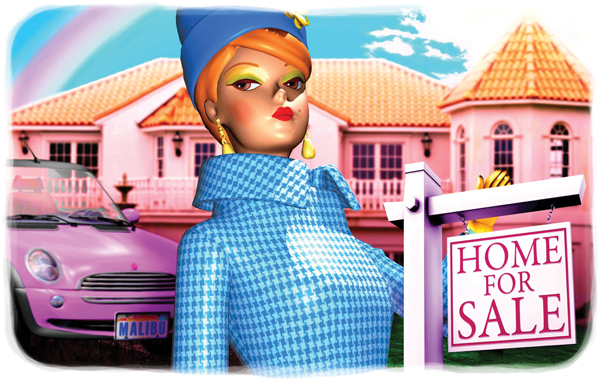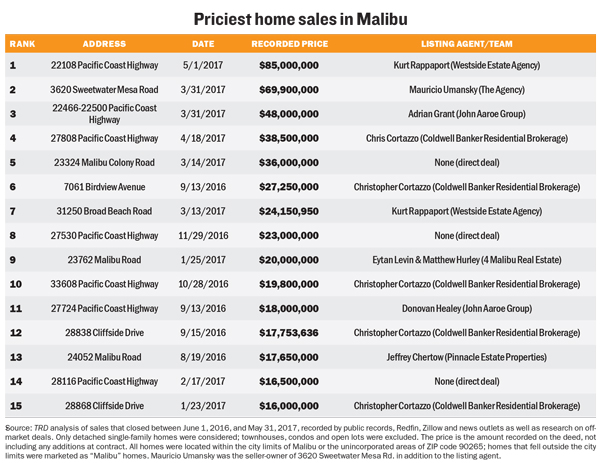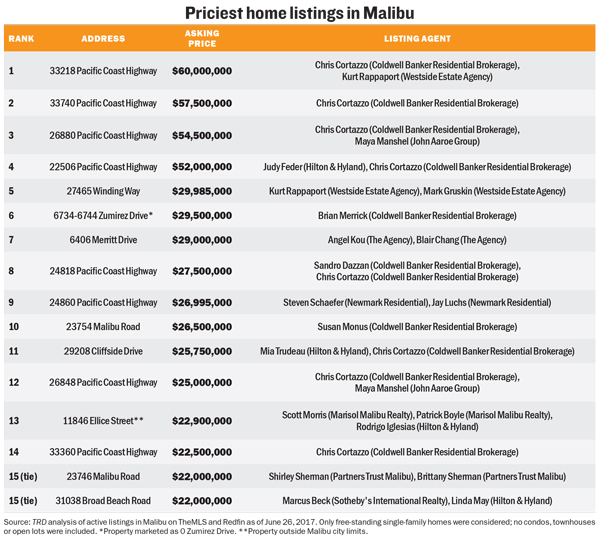Updated Monday, July 24, 2017 at 3:58 p.m.: If real estate mogul Sean Conlon, Leonardo DiCaprio and Miley Cyrus walk into a bar, there’s a good chance it’ll be in Malibu.
The beachside community with 21 miles of coastline has served as a retreat for Hollywood’s elite since the late 1920s. Malibu represents the quintessential California lifestyle of surf, sun and sand — even getting its own namesake Barbie doll in 1971, sporting an aqua blue bathing suit and toting a yellow beach towel.
While Malibu has primarily been a market for the very well-heeled looking for second or third homes (or 12 of them, if you’re Larry Ellison), a revamped downtown — soon to see even more changes with the recent reversal of anti-development legislation — has helped to attract more L.A. buyers than ever before, and more of them are looking for primary residences.
Sale prices skyrocket
Residential sale prices in the area are climbing ever higher, with a whopping $85 million deal in May beating out the previous record set in 2013 with the $75 million sale of billionaire Howard Marks’ Carbon Beach home.
The $85 million deal for 22108 Pacific Coast Highway sits at the top of The Real Deal’s rankings of the priciest Malibu home sales from June 1, 2016, to May 31, 2017. Both off-market and recorded sales were ranked, and the sale prices listed reflect the amounts recorded on deeds, excluding any additions — whether they be cars, furniture or artwork — at contract.
As homes on the high end go up in price, midpriced homes are following suit. In addition to a 20 percent year-over-year uptick in the number of single-family home sales in Malibu in the first quarter of 2017, the median sales price for the first quarter was up 14 percent to $2.79 million from the same period last year, according to Douglas Elliman. Compare that to the numbers for greater Los Angeles, including Westside and Downtown L.A., where the median single-family home sales price rose in the first quarter by 5.9 percent to $1.45 million.
But Malibu is clearly quite a different territory than L.A. at large. Developer Scott Gillen, founder of development firm Unvarnished, said that up until now, the enclave has been a city for buyers looking to purchase their second, third or even fourth home — not a primary residence.
“I think that’s largely because of the lack of amenities,” Gillen said. “[But now] there’s more to do, there’s more places to go, and it’s a very coveted beach community. Malibu is on the map, but I think as a primary residential community, we’re about to make some major changes.”
And those changes are indeed afoot. Despite its well-established celebrity cachet, Malibu has never had much of a downtown scene until now. The openings of the exclusive luxury hotel Nobu Ryokan Malibu in April and the members-only club Soho House in May have created a draw to the downtown area.
In addition to that, a new court ruling will pave the way for more practical amenities in the area. Last month, developer Steve Soboroff scored a win when a state appeals court upheld a lower court’s ruling to overturn Measure R, a voter-backed law that would limit chain stores and force major retail projects to be put to a public vote in Malibu. The decision means Soboroff will be able to open a roughly 24,000-square-foot Whole Foods in his estimated 38,000-square-foot retail center in Malibu’s Civic Center area.
Gillen, who has lived in Malibu for more than 30 years, said that the reversal of Measure R will help loosen the city’s control on new development.
“I love living here because the demand for real estate is high, which keeps the values strong,” he said. “I hate working here because it’s a fight.”
Broker Sandro Dazzan of Coldwell Banker Residential Brokerage said the new nightlife options have allowed high rollers to develop a taste for what Malibu offers in a way that was previously unavailable.
“Five, 10 years ago those kinds of venues did not exist,” Dazzan said. “So, if you were a visiting international billionaire, you might drive through Malibu and not really get it. Today, you’re probably going to Soho House and you might even stay at the new Nobu hotel. These venues give those types of buyers a way to experience the lifestyle that we have here.”
Malibu has always been an expensive city because of its large, luxury homes geared to the very wealthy, but record sales have grown significantly over the years. And with a higher number of interested potential buyers competing for a small number of homes, prices are climbing higher, said Mauricio Umansky, chief executive of the Agency.
His Beverly Hills-based luxury brokerage firm will be opening an outpost across the street from the Nobu Malibu restaurant in August, joining Compass, which opened its Malibu office in 2016, and Douglas Elliman, which officially opened an office there in July.
“The Malibu market is super-hot,” Umansky told TRD. “[And] God’s not making any more land next to the ocean.”
In March, Umansky partnered with investor Mauricio Oberfeld to sell a $69.9 million Sweetwater Mesa Road compound to Hong Kong billionaire Karen Lo, the second-biggest sale in TRD’s rankings. The 15-acre property has a golf course, ponds and a tennis court in addition to the 15,000-square-foot residence.
It was the biggest sale of a non-oceanfront property ever in Malibu.
Oberfeld and Umansky scooped up the home last year for $38 million from the U.S. Justice Department, which had seized it from the previous owner, Teodoro Nguema Obiang Mangue, the playboy son of Equatorial Guinea’s president, Teodoro Obiang Nguema Mbasogo. The younger Obiang was accused of using funds pilfered from his home country to pay for the house. He turned the home over to settle federal prosecutors’ claims.
And that’s not the only uber-luxury deal to cause a splash.
“[Malibu had] six sales this year that are already higher than the highest sales last year,” Dazzan said. “And two of those are record-breaking sales.”
Mark Walter, founder and chief executive of Guggenheim Partners — which owns the Los Angeles Dodgers — was the buyer in the record-breaking $85 million deal for music mogul David Geffen’s Carbon Beach spread. Kurt Rappaport of Westside Estate Agency handled the sale.
The property, originally five parcels but combined into two, gained notoriety in 2002 when Geffen filed a lawsuit against state officials to block public access to the beach near his home. He even built fake garage doors to keep people from parking on the road in front of his house. Geffen lost his battle in 2005.
Asking top dollar
These big-money deals are increasingly pushing listing prices higher. In TRD’s ranking of the priciest active Malibu listings on the MLS and Redfin as of June 26, 2017, the top four single-family home properties were all priced above $50 million. The two lowest-priced homes in the ranking tied for the No. 15 spot at $22 million — certainly nothing to sneeze at.
Tight inventory is also bolstering sellers’ confidence when it comes to pricing. Dazzan said it can be tough for a buyer looking to purchase a new or remodeled home in the $20 million-to-$30 million range in Malibu compared to Beverly Hills or Bel Air, where there are many more listings in the same price range.
“There’s not a lot of new, sexy, modern architecture out here,” he said. “Older homes that need to be redone on a fantastic site aren’t easy to do and can take years to remodel because the city’s so restrictive.”
Dazzan said renovations done to more than 50 percent of a home are considered new development by the city. So buyers hoping to simply gut old homes may have to go through the roughly two- to three-year permitting process new developments often face.
As a result, Malibu isn’t experiencing the spec mansion craze now seen in Beverly Hills and Bel Air. The bureaucratic hurdles faced by developers make it difficult, especially when dealing with the notoriously tough California Coastal Commission and environmental activists.
It’s a process that took U2 guitarist David “The Edge” Evans 12 years to navigate.
Evans and his wife, Morleigh Steinberg, have been trying to build their dream home, called the Sweetwater Mesa Project, after purchasing a 151-acre site for nearly $9 million in 2005, according to property records. The couple planned to drop $79 million to construct five single-family homes ranging from 7,812 to 9,572 square feet.
After years of back-and-forth over the homes’ design and potential environmental impact, the Coastal Commission approved the project in December 2015.
But the Sierra Club filed a petition in January 2016 to halt the development, citing potential negative effects on air quality and a spike in greenhouse gas pollution.
However, a Superior Court judge rejected the Club’s petition this April, allowing the musician to start construction.
Umansky said that those looking to build face more of an uphill battle in Malibu than in neighboring cities.
“You’re dealing with the [California] Coastal Commission [and] you’re dealing with the city of Malibu — a much more stringent city and much more difficult to develop in versus the rest of L.A.,” he said.
Donovan Healey, estates director at brokerage firm John Aaroe Group, said new homes in Malibu don’t last long on the market.
“New product is rare, and it’s in high demand,” Healey said. “Even a lot of the spec builders are in the market now.”
A seaside escape, and more
But the sky-high prices are worth it to those with deep pockets. Santiago Arana of the Agency said Malibu offers something every wealthy investor and celebrity wants: space.
“It’s not just being on the beach or PCH,” Arana said. “You have amazing 3-, 4-, 10-acre properties on the other side of PCH. Celebrities love it because it’s very private. They get to do a lot of things you don’t get to do in the city because of the limitation of space.”
When Lady Gaga wanted room to stretch out, Arana and Umansky sold the singer a 10,000-square-foot home with an eight-stall horse stable and dressage ring for $23 million. The 6-acre property, which sold in 2014, also included a bowling alley and 800-bottle wine cellar.
But not all buyers have to drop double-digit millions to own a slice of Malibu.
With prices starting at $1.23 million, demand has been high for the 68-unit luxury condominium project Cavalleri in Point Dume.
John Pallante, senior director at the Mark Company, which is handling the project’s sales, said the company knew there would be mass appeal for the development because its units were extensively remodeled.
“What we overheard, astoundingly, from brokers and buyers was that in this price range, between $1 to $2 million, you don’t find new product or even houses or condos that are renovated [in Malibu],” Pallante said.
San Francisco-based real estate manager Pacific Eagle Holdings purchased the former Villa Malibu rental community in September 2016, paying $62 million to previous owner Carlyle Group, a private equity firm in Washington, D.C.
Pacific Eagle revamped the property with gourmet kitchens and eco-friendly details inside the units and partnered with concierge management company Luxury Attaché. It also built amenities such as dog parks, a yoga terrace, tennis and bocce courts and a meditation labyrinth.
“Malibu is unique in that a lot of people have second homes here [but] only live 40 minutes away,” Pallante said. “You also get a lot of people that can have it as their primary residence because they can be in town in an hour.”
Dazzan said potential buyers were often uncertain about living in Malibu because the nightlife and action were often found in neighboring cities. Ten years ago, buyers would have quickly chosen a city like Beverly Hills because Malibu lacked a wide selection of shops and restaurants.
But with new retailers ready to enter the market, like Whole Foods and Dean & DeLuca — which is under construction in Malibu Village — along with stores that already opened this year, including apparel brands Paige and Lauren Moshi and bike shop Ebikezzz, that is changing.
“Today, you get people that live in Beverly Hills going to Malibu to go shopping or to dinner,” Dazzan said. “That didn’t happen 10 years ago. I’ve been here my whole life, and it’s wild to see.”
—Harunobu Coryne provided research for this article


